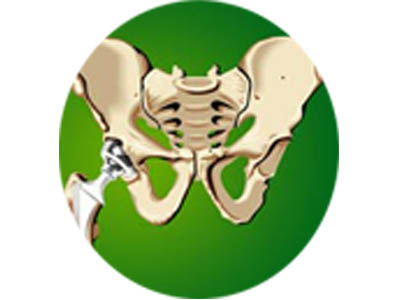
Hip Replacement
Q> What are the different types of hip replacement surgery?
There are two main types of hip replacement surgery, but a number of different components and surgical techniques may be used.
Total hip replacement
In a total hip replacement, part of the thigh bone (femur) including the ball (head of femur) is removed and a new, smaller artificial ball is fixed into the rest of the thigh bone. The surface of the existing socket in the pelvis (the acetabulum) is roughened to accept a new socket component that will join up (articulate) with the new ball component.
Total hip replacement is an excellent treatment option for people with late-
Many artificial joint components are fixed into the bone with acrylic cement. However, it’s becoming more common, especially in younger, more active patients, for one part (usually the socket) or both parts to be inserted without cement. If cement isn’t used, the surfaces of the implants are roughened or specially treated to encourage bone to grow onto them. Bone is a living substance and, as long as it’s strong and healthy, it’ll continue to renew itself over time and provide a long-lasting bond. Where only one part is fixed with cement, it’s known as a hybrid hip replacement.
The hip replacement parts can be plastic (polyethylene), metal or ceramic and are used in different combinations:
- Metal-on-plastic (a metal ball with a plastic socket) is the most widely used combination.
- Ceramic-on-plastic (a ceramic ball with a plastic socket) or ceramic-on-ceramic (where both parts are ceramic) are often used in younger, more active patients.
- Metal-on-metal (a metal ball with a metal socket) is very occasionally used in younger, more active patients.
Metal-on-metal hip resurfacing
Resurfacing the original socket and the ball of the thigh bone is a different form of total hip replacement surgery. Instead of removing the head of the thigh bone and replacing it with an artificial ball, a hollow metal cap is fitted over the head of the thigh bone. The socket part of the joint is also resurfaced with a metal component.
People who have this type of operation have a lower risk of dislocation and may be able to return to a higher level of physical activity compared with those having a conventional hip replacement.
This type of hip surgery is linked with a release of metal particles from the joint replacement materials, which may cause local inflammatory reactions and have unknown effects on your general health. Complication rates are particularly high in older patients and in women. Metal-on-metal resurfacing isn’t suitable for people with low bone density or osteoporosis where the bones are weakened.
Q> How should I prepare for hip replacement surgery?
Once you’ve decided to go ahead with the operation, your name will be put on a waiting list and the hospital will contact you, usually in the next 6–8 weeks.
Pre-admission clinic
Most hospitals invite you to a pre-admission clinic, usually about 2–3 weeks before the surgery. You’ll be examined to make sure you’re generally well enough for the anaesthetic and the operation. This may involve the following tests:
- blood tests to check for anaemia and to make sure your kidneys are working properly
- x-rays of your hip
- a urine sample to rule out infection
- an electrocardiogram (ECG) tracing to make sure your heart is healthy.
The hospital team will probably tell you at this stage whether the operation will go ahead as planned. It’s also advisable to have a dental check-up and get any problems dealt with well before your operation. There’s a risk of infection if bacteria from dental problems get into your bloodstream.
You should discuss with your surgeon, anaesthetist or nurse at this pre-admission clinic whether you should stop taking any of your medications or alter the doses before you have surgery. Different units and different surgeons may have differing opinions on this.
At this visit you may also see an occupational therapist to discuss how you’ll manage at home in the weeks after your operation. They’ll also advise you on aids and appliances that might help.
Q> What are the possible advantages of a hip replacement surgery?
Freedom from pain is the main possible advantage of hip replacement surgery, along with improved mobility. Both of these should improve your quality of life. You’ll have some pain from the surgery to begin with but you should soon start to notice improvements soon after the operation.
Q> How long will the new hip joint last?
Back to Hip replacement surgery, Your new hip should allow you virtually normal, pain-free activity for many years. Around 80% of cemented hips should last for 20 years. Younger, more active patients often get cementless hip replacements and these may last longer, although this isn’t confirmed in long-term studies.
Revision surgery
Repeat hip replacement surgery are possible and great advances have been made in this type of surgery in recent years. Revision surgery is more complex than the original operation, the time in hospital is longer and the results are slightly less good with each revision. Even so, over 80% of patients report success for 10 years and more.
Some revisions may need a bone graft, where a piece of bone is taken from another part of the body or from a donor patient to help replace bone loss. Bone grafts may need protection from movement, and this might mean that you’ll be on crutches for longer. However, the eventual result is usually good.
